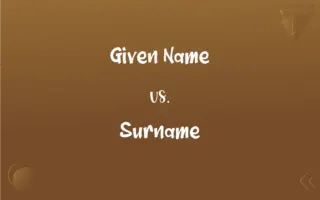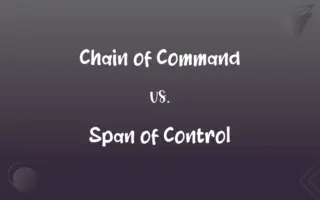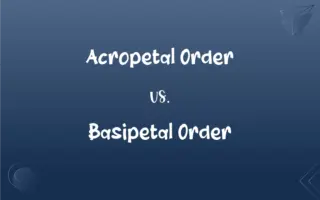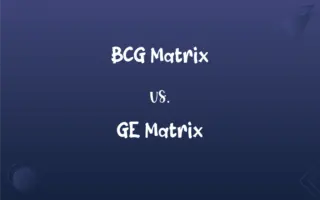Break vs. Continue: What's the Difference?
Edited by Aimie Carlson || By Harlon Moss || Published on February 6, 2024
Break terminates the current loop entirely; continue skips the rest of the current loop iteration and proceeds to the next iteration.

Key Differences
The break statement in programming is used to exit a loop prematurely, regardless of whether the loop's condition is true or false. On the other hand, continue is used to skip the current iteration of the loop and move directly to the next iteration. This fundamental difference alters the flow of control within loops.
When break is encountered in a loop, it causes an immediate exit from that loop. This is useful for stopping a loop when a certain condition is met, or an event occurs. Continue, however, does not exit the loop but merely skips over the remaining part of the current loop iteration, often based on a specific condition.
Break is typically used in scenarios where continuing the loop serves no purpose or might lead to incorrect or undesired results. In contrast, continue is used when only certain conditions within a loop should lead to the skipping of specific actions, but the loop should continue running.
The use of break can be seen in loops that search for items in a collection; once the item is found, the loop can be exited. Continue is often seen in loops that process lists of items, where certain items might not need processing, and thus, the loop skips to the next item.
While break contributes to loop termination, continue contributes to loop efficiency by allowing the omission of unnecessary iterations. Their proper use is essential in controlling the flow of execution in loops effectively.
ADVERTISEMENT
Comparison Chart
Loop Control
Terminates the loop entirely
Skips to the next iteration of the loop
Typical Use
Exiting a loop when a condition is met
Skipping part of an iteration
Flow of Execution
Causes an immediate exit from the loop
Continues execution at the next iteration
Scenario Example
Stop searching once an item is found
Ignore certain items in a processing loop
Effect on Loop Execution
Ends loop execution
Continues loop with the next cycle
ADVERTISEMENT
Break and Continue Definitions
Break
Exits a loop or switch statement.
If the file is not found, break out of the loop.
Continue
Skips the remaining part of a loop iteration.
If the input is invalid, continue to the next loop iteration.
Break
Can be used in switch statements.
In a switch case, break prevents fall-through.
Continue
Used to bypass parts of code in a loop.
Continue is used to skip logging when debug mode is off.
Break
Used to terminate loops early.
Break is used to stop the iteration once the condition is met.
Continue
Avoids executing code below it in the loop.
Continue if the list item is marked as processed.
Break
Stops the current flow of control.
Use break to exit a loop when an error occurs.
Continue
Proceeds to the next iteration of the loop.
In data processing, continue to ignore null entries.
Break
Useful for breaking out of nested loops.
Break is essential for exiting multi-layered loops.
Continue
Helps in managing loop execution effectively.
Use continue to handle special cases in loops.
Break
To cause to separate into pieces suddenly or violently; smash.
Continue
To go on with a particular action or in a particular condition; persist
We continued until the job was finished.
FAQs
What does break do in a loop?
Exits the loop entirely.
What happens when break is executed in a nested loop?
It exits only the innermost loop where it's used.
What type of loop is continue most useful in?
Loops where certain conditions require skipping some iterations.
Can continue be used in nested loops?
Yes, but it only affects the loop where it's placed.
How does continue affect loop counters?
It does not affect the counters; the loop continues as normal.
Is break a loop control mechanism?
Yes, it controls the flow by terminating loops.
What is the purpose of continue?
To skip the current loop iteration and proceed to the next.
Is continue applicable in a switch statement?
No, it's used only in loops.
Does break terminate a program?
No, it only exits the loop or switch statement.
Can break be used in infinite loops?
Yes, it's often used to provide an exit condition.
Can break be used in all types of loops?
Yes, in for, while, and do-while loops.
Is break necessary in a switch-case structure?
Yes, to prevent fall-through in C and C++.
Does continue start the next iteration immediately?
Yes, it skips the rest of the code and starts the next iteration.
What should be considered when using break?
The logical flow, to ensure it doesn't exit loops prematurely.
Is continue helpful in error handling within loops?
Yes, to skip over iterations that might cause errors.
Can break be used multiple times in the same loop?
Yes, in different conditional branches.
How can continue improve loop performance?
By avoiding unnecessary code execution within iterations.
Can continue be used to skip processing certain data?
Yes, particularly when certain conditions are met.
Does break work with conditional statements inside loops?
Yes, it's often used within if-else structures in loops.
Does continue affect the final outcome of a loop?
It can, by altering which iterations of the loop are fully executed.
About Author
Written by
Harlon MossHarlon is a seasoned quality moderator and accomplished content writer for Difference Wiki. An alumnus of the prestigious University of California, he earned his degree in Computer Science. Leveraging his academic background, Harlon brings a meticulous and informed perspective to his work, ensuring content accuracy and excellence.
Edited by
Aimie CarlsonAimie Carlson, holding a master's degree in English literature, is a fervent English language enthusiast. She lends her writing talents to Difference Wiki, a prominent website that specializes in comparisons, offering readers insightful analyses that both captivate and inform.


































































